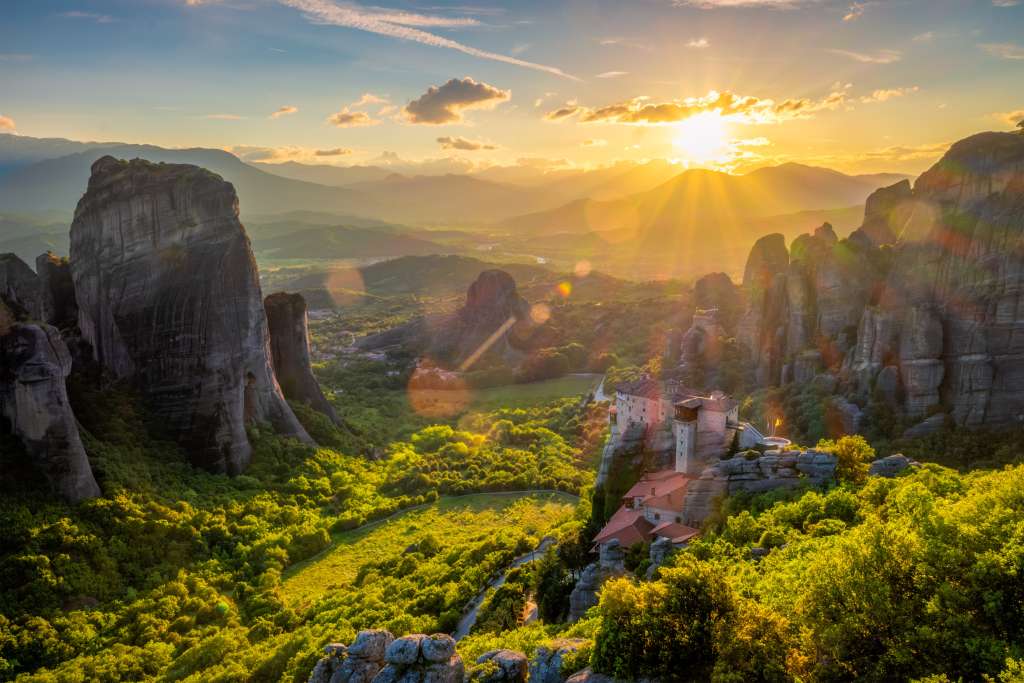Over 60 million years ago, earthquakes created these astonishing rock formations in the centre of the Pinios valley in Thessaly. And whether you believe geologists or Greek mythology is up to you, as legend has it that these giant rocks were merely the remnants of the battleground between the Titans and the Olympian Gods.
But those impressive vertical rocks became a sanctuary during the 14th century for hermit monks and even monastical communities, which built their monasteries in precarious ways next to sheer cliffs and using nothing more than winches and baskets.
These monasteries were secluded areas, largely protected by constant Ottoman attacks and many of them even featured fortifications as a means of defending the holy sanctuary. Of the 24 monasteries originally built, six are still inhabited today, all perched on top of rocks with majestic views, earning the UNESCO World Heritage Site title deservingly. Speaking of the views from the top, the landscape is truly mesmerising, with the sun setting across the valley behind the huge mountain range of Pindus, bathing Meteora with beautiful orange sunlight.
The panoramic views are reason alone to visit this astonishing area, with Byzantine era monasteries being an extra bonus. In many of them visitors can still see the original winches, used to transport people and resources to the monasteries. This means of transport was, of course, not for the faint-hearted and was feared by many, although it was the most effective way of keeping intruders away. Famously during the start of the 20th century, the well-known French-Swiss photographer Fréderic Boissonnas visited Meteora, capturing stills of the monastic life and making it well-known across the globe, and experiencing first hand the «art» of hermetic life on top of those imposing monoliths.
Today, visitors choose to bike or hike and even rock-climbing on the massive vertical cliffs, visit the prehistoric cave of Theopetra, at a height of nearly 100 metres, which features rewarding views, educational tours and the river of the city of Trikala, Litheos, flowing right next to it. While inside the cave, footsteps dating almost 130 thousand years ago will give you an idea of prehistoric life in the caves.
Info
- Meteora Museum
- Cave of Theopetra
Admission Fee: 3 Euros
- Meteora Monasteries
Opening Hours:
- Monastery of St. Nicholas: 9:00 – 15:30 (closed on Fridays)
- Monastery of St. Stephen: 9:00 – 13:30 and 15:30 – 17:30 (closed on Mondays)
- Monastery of the Holy Trinity: 10:00 – 15:00 (closed on Wednesdays and Thursdays)
- Monastery of Varlaam: 9:00 – 16:00 (closed on Fridays)
- Monastery of the Great Meteoron: 9:00 – 17:00 (closed on Tuesdays)
- Roussanou Monastery: 9:00 – 18:00 daily
What is included :
- All pickups and drop-offs: we will take you from and where you need to go
- A high-quality car with an English-speaking professionally trained driver
- Complimentary wi-fi onboard
- Water and refreshments
- Fuel and tolls
- All taxes, fees and handling charges
What isn’t included:
- Admission fees for archaeological sites, museums and monuments
- Official tour guide (however you can request one you complete your booking)
- Meals or other beverages
- Tips and gratuities

